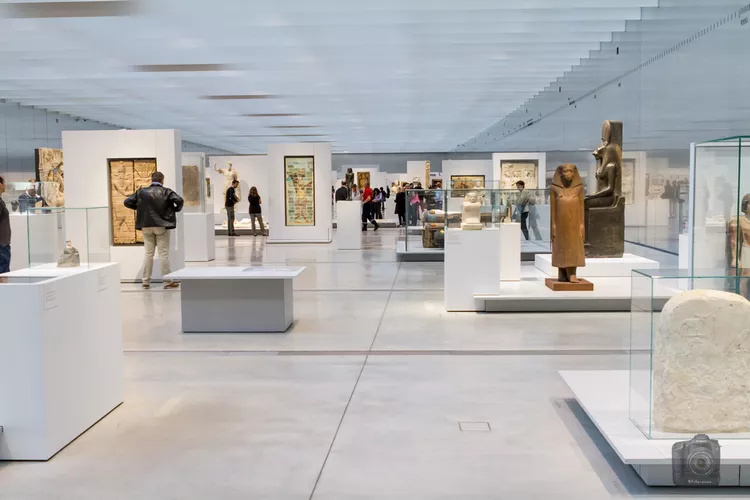Summary
The Louvre-Lens: A Cultural Gem in Northern France
The magnificent, world-renowned Louvre Museum has ventured outside its Parisian home to create a new cultural landmark in this area of Northern France. It aims to provide the local residents, along with many foreign visitors, access to the finest art in the world within a spectacular setting, while also helping to revive the once-thriving mining town of Lens and its surroundings.
The Location
Lens may not seem like an obvious choice for tourists. The mining town was devastated during World War I, occupied by Nazis, and bombed by Allied forces during World War II. Although the mines continued operations post-war and the area features impressive slag heaps, the industry began to decline significantly, leading to the closure of the last mine in 1986 and a stagnated town.
Consequently, the Louvre-Lens is viewed by authorities as a pivotal step towards rejuvenating the area, akin to the transformations seen with the Pompidou-Metz Museum in Metz, Lorraine, and the Guggenheim Museum in Bilbao, Spain.
Moreover, Lens was strategically chosen for its location—it lies just south of Lille, with the Channel Tunnel to the U.K. a mere hour’s drive away, allowing for convenient day trips. Belgium is just a 30-minute drive, while the Netherlands is roughly two hours away. It’s centrally positioned within a densely populated region, with hopes that visitors will extend their tours to combine the Louvre-Lens experience with explorations of Lille and the nearby World War I battlefields and memorials.
The Building
The new Louvre-Lens is housed in a series of five striking low-rise buildings made of glass and polished aluminum, each connecting at various angles. The panoramic park surrounding the museum reflects beautifully in the glass, enhancing the overall aesthetics while allowing ample natural light indoors.
The Japanese architectural firm SANAA, led by Kazuyo Sejima and Ryue Nishizawa, won an international competition to design this masterpiece. The project commenced in 2003, costing around 150 million euros (£121.6 million; $198.38 million) and took three years to complete.
The Galleries
The museum is divided into distinct sections. Visitors are encouraged to start at the Galerie du Temps, the main gallery which showcases 205 significant artworks spread over 3,000 square meters without any dividing walls. As you enter, the expansive space filled with unique masterpieces creates an impressive ‘Wow’ moment. The gallery illustrates the ‘long and visible progress of humanity’ that is emblematic of the main Louvre in Paris.
The exhibits span from the origins of writing to the mid-19th century, with the gallery subdivided into three key timeframes: Antiquity, the Middle Ages, and the Modern period. Contextual maps and brief explanations help navigate this historical journey. As you wander through, dates marked on a reflective wall provide a sense of chronological order, allowing visitors to appreciate the cultural significance of each era through their iconic works.
- Antiquity: Includes 70 artifacts from Mesopotamia, Egypt, classical Greece, and the Roman Empire, demonstrating the cradle of Mediterranean civilization.
- The Middle Ages: Comprises 45 works spread across seven themed sections, showcasing influences from Eastern and Western Christianity, as well as remarkable Gothic art.
- Modern Art: Features 90 works divided into nine themed sections, highlighting the magnificent Renaissance and Baroque innovations, alongside Islamic artistry.
The museum’s offerings are impressive, from exquisite ancient Greek marble statues and Egyptian mummies to stunning Italian church mosaics and masterful Renaissance ceramics. The grand Delacroix piece, La Liberté guidant le peuple (Liberty Leading the People), aptly encapsulates the revolutionary spirit on display.
The Pavilion de Verre
Transitioning from the Galerie du Temps, visitors enter the smaller Pavilion de Verre, where the audio accompaniment consists of soothing music rather than commentary. Comfortable seating invites a moment to relax and enjoy views of the picturesque countryside.
This section hosts two exhibitions: A History of Time, which examines our perception of time, and a rotating temporary exhibition. Friendly curators are on hand to provide insights, making the experience feel personal and guided.
Temporary Exhibitions
During your visit, allocate time to explore the temporary exhibitions, which are major highlights. While most works are borrowed from the Louvre, noteworthy pieces from other prominent French galleries and museums are also on display.
Practical Information
Louvre-Lens
Lens
Nord–Pas-de-Calais
Museum website (in English)
The grounds feature a shop, café, and restaurant.
Opening times:
Wednesday to Monday: 10 AM – 6 PM (last entry 5:15 PM)
September to June, first Friday of each month: 10 AM – 10 PM
Closed: Tuesdays, January 1, May 1, December 25.
Entry: Free for the main museum; Exhibition entry: 10 euros, 5 euros for ages 18 to 25; free for visitors under 18.
How to Get There
By train:
Lens train station is centrally located, with direct connections from Paris Gare du Nord and nearby locales like Lille, Arras, Béthune, and Douai. A free shuttle service runs regularly from the station to the Louvre-Lens museum, with a pleasant 20-minute walk available as well.
By car:
Lens is conveniently located near key motorways, including the major routes connecting Lille and Arras, alongside the A1 (Lille to Paris) and A26 (Calais to Reims). If arriving via ferry from Calais, follow the A26 towards Arras and Paris, taking exit 6-1 to Lens. Look for signs directing you to the Louvre-Lens Parking area.
Being close to Lille, it’s suggested to combine your visit with a journey to this vibrant city.





